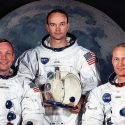For the uninitiated
50 years ago yesterday Neil Armstrong and Buzz Aldrin landed the Apollo 11 lunar module Eagle on the surface of the moon, and as Neil stepped from one of the module’s landing-leg platforms onto the luanar surface and uttered his famous line, “That’s one small step for a man, one giant leap for mankind,” the notion of flying to and exploring worlds beyond our own became thus cemented into human, US history and was no longer merely the speculations of many science fiction authors.
Now that you’re all caught up
For all the crap I talk about Google I have to say I have long appreciated how they always make a doodle to celebrate anniversaries of scientific achievements. I am pleased to report Google didn’t let me down for this spectacle either: for those who may have missed it, they made a touching animation narrated by Apollo 11’s command module pilot Michael Collins exploring just how impressive that mission really was.
One of my own favorite fun facts is how the entire Apollo series relied on a computer (the Apollo Guidance Computer) with 0.043MHz clock speed that ran on at most a few hundred megabytes of information, and its clock: about 127 million times slower than the iPhone 6’s 64 bit Cortex A8 ARM architecture.
One of my other take-aways was nearer the end of the animation when Collins reaffirms one the underlying philosophies of what it takes to accomplish large-scale scientific endeavors, everyone. When they came back they went on a tour of the world and everywhere they visited people would say, “We did it,” as a testament to what our species can accomplish when we set aside our differences.
In a rare interview with Neil Armstrong back in 2011 he mentions how even when he and Buzz were descending to the lunar surface and made a successful touchdown on “fumes” the two didn’t spend a great deal of time meditating over the accomplishment. To hear Neil tell it was a handshake between him and Buzz, and then back to work. And then again while he and Buzz were on the surface working through their checklist of “get these done while you’re up there,” the US President calls the phone on the lunar module from the Oval office to congratulate him and the entire team for just landing the module. And to paraphrase Neil’s response, “Thanks, Mr. President. There’s still lots of work to be done…,” and, frankly, there will never be an end to the workload when it comes to making scientific progress. Every answer brings a hundred more questions.
That there is always more work to be done raises a fundamental question: why haven’t we gone back to the moon since Apollo? Many theories have been posited, but the short answer is finance. It is an expensive endeavor to send even three people to another rock, and since NASA was begat from and remains a government entity it’s the American taxpayers who get to float the bill. What really pushed Americans to consent to floating the bill for this mission was the burning desire to not come in second place to Russia in the space race.
Fortunately, today neither are relations between the US and Russia as tense as they were back then nor is the mission of space exploration solely a NASA (or US Government) enterprise. Thanks to private agencies like Blue Origin, Northrop Grumman (formerly OrbitalATK), and Lockheed Martin new technologies are emerging all the time to improve everything about space exploration from mission longevity to the overall health and comfort of the astronauts themselves.
Blue Origin’s New Shepard project is streamlining “recyclable” rocketry! Northrop Grumman’s unmanned cargo transporter Cygnus has been making regular deliveries to the International Space Station since 2017, which you can read more about here. One of Lockheed’s many projects is the AA-2, a safety abortion mechanism designed to ensure any Orion spacecraft crew’s safe return to Earth in the event that a mid-launch abortion becomes necessary.
Hopefully in the next 50 years we’ll have something in the way of either a fueling station between Earth and the moon and perhaps establish some between the moon and Mars and/or even a long-term lunar colony setup, more ideas can be found here.
As an added bonus I hope to be able to add a collage of imagery from newspaper clippings from July 20th 1969 to this article in a few days.





